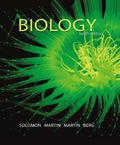
Concept explainers
Introduction: Carbon occurs widely in nature in both inorganic and organic forms. Organic compounds are chemical compounds, where carbon atoms form the backbone of the molecule by bonding covalently. The inorganic forms of carbon are very simple carbon compound that are not bonded either to hydrogen or another carbon.
Answer to Problem 1TYU
Correct answer: Carbon is particularly well suited to be the backbone of organic molecules because it can bond to atoms of a large number of other elements. Hence, the correct answer is option (d).
Explanation of Solution
Reasons for the correct answer:
Option (d) is given as “it can bond to atoms of a large number of other elements”.
Carbon serves as the backbone of large molecules as carbon–carbon bonds are strong as compared to other bonds. Carbon atoms form straight or branched chains or rings. A greater number of covalent bonds with different atoms is formed by carbon atoms than the other atoms.
Hence, the correct answer is option (d).
Reasons for incorrect answers:
Option (a) is given as “it can form both covalent bonds and ionic bonds”.
Carbon atoms can only form covalent bonds not ionic bonds. Hence, option (a) is incorrect.
Option (b) is given as “its covalent bonds are very irregularly arranged in three-dimensional space”. Covalent bonds of carbon are accurately arranged in 3-D space. Hence, option (b) is incorrect.
Option (c) is given as “its covalent bonds are the strongest
Carbon covalent bonds are the strongest chemical bonds, but there are other elements whose covalent bonds are stronger than carbon. For example, carbon–hydrogen sigma covalent bonds are stronger than carbon–carbon covalent bonds. Hence, option (c) is incorrect.
Option (e) is given as “all the bonds it forms are polar”.
Carbon can also form non-polar bonds. Hence, option (e) is incorrect.
Hence, options (a), (b), (c), and (e) are incorrect.
Carbon serves as the backbone of organic molecules because it can bond to atoms of a large number of other elements.
Want to see more full solutions like this?
Chapter 3 Solutions
EBK BIOLOGY
- Using quail and chick embryos, quail-specific antibody and fluorescent tissue-specific antibodies, design an experiment where you investigate the tissues the cranial neural crest can give rise to. What are four derivatives of the cranial neural crest that you expect to see in the resulting chimeric embryos?arrow_forwardDoes the neural crest have to undergo epithelial to mesenchymal transition prior to migration through the developing embryo? Does the neural crest differentiate into different cell types based on their axial position along the anterior and posterior axis?arrow_forwardUsing quail and chicken embryos, what kind of experiment would you conduct to test if rib forming somites have their axial identity specified before segmentation? How do we know this phenotype is due to axial identity being specified before segmentation and not due to our experimental method?arrow_forward
- 8. Aerobic respiration of a 5 mM solution of tripeptide that is composed of the following three amino acids; alanine, leucine and isoleucine. Alanine breaks down to pyruvate, leucine breaks down to Acetyl-CoA and isoleucine breaks down to succinyl-CoA. Alanine NADH FADH2 OP ATP SLP ATP Total ATP Leucine Isoleucine Totals Show your work using dimensional analysis here: 4arrow_forward9. Aerobic respiration of one lipid molecule. The lipid is composed of one glycerol molecule connected to two fatty acid tails. One fatty acid is 12 carbons long and the other fatty acid is 18 carbons long in the figure below. Use the information below to determine how much ATP will be produced from the glycerol part of the lipid. Then, in part B, determine how much ATP is produced from the 2 fatty acids of the lipid. Finally put the NADH and ATP yields together from the glycerol and fatty acids (part A and B) to determine your total number of ATP produced per lipid. Assume no other carbon source is available. fatty acids glycerol 18 carbons 12 carbons 0=arrow_forwardinfluences of environment on the phenotype.arrow_forward
- What is the difference between codominance and phenotypic plasticity?arrow_forwardExplain the differences between polygeny and pleiotropy,arrow_forwardIf using animals in medical experiments could save human lives, is it ethical to do so? In your answer, apply at least one ethical theory in support of your position.arrow_forward
- You aim to test the hypothesis that the Tbx4 and Tbx5 genes inhibit each other's expression during limb development. With access to chicken embryos and viruses capable of overexpressing Tbx4 and Tbx5, describe an experiment to investigate whether these genes suppress each other's expression in the limb buds. What results would you expect if they do repress each other? What results would you expect if they do not repress each other?arrow_forwardYou decide to delete Fgf4 and Fgf8 specifically in the limb bud. Explain why you would not knock out these genes in the entire embryo instead.arrow_forwardYou implant an FGF10-coated bead into the anterior flank of a chicken embryo, directly below the level of the wing bud. What is the phenotype of the resulting ectopic limb? Briefly describe the expected expression domains of 1) Shh, 2) Tbx4, and 3) Tbx5 in the resulting ectopic limb bud.arrow_forward
 Human Biology (MindTap Course List)BiologyISBN:9781305112100Author:Cecie Starr, Beverly McMillanPublisher:Cengage Learning
Human Biology (MindTap Course List)BiologyISBN:9781305112100Author:Cecie Starr, Beverly McMillanPublisher:Cengage Learning Biology 2eBiologyISBN:9781947172517Author:Matthew Douglas, Jung Choi, Mary Ann ClarkPublisher:OpenStax
Biology 2eBiologyISBN:9781947172517Author:Matthew Douglas, Jung Choi, Mary Ann ClarkPublisher:OpenStax Biology (MindTap Course List)BiologyISBN:9781337392938Author:Eldra Solomon, Charles Martin, Diana W. Martin, Linda R. BergPublisher:Cengage Learning
Biology (MindTap Course List)BiologyISBN:9781337392938Author:Eldra Solomon, Charles Martin, Diana W. Martin, Linda R. BergPublisher:Cengage Learning Concepts of BiologyBiologyISBN:9781938168116Author:Samantha Fowler, Rebecca Roush, James WisePublisher:OpenStax College
Concepts of BiologyBiologyISBN:9781938168116Author:Samantha Fowler, Rebecca Roush, James WisePublisher:OpenStax College Biology: The Dynamic Science (MindTap Course List)BiologyISBN:9781305389892Author:Peter J. Russell, Paul E. Hertz, Beverly McMillanPublisher:Cengage Learning
Biology: The Dynamic Science (MindTap Course List)BiologyISBN:9781305389892Author:Peter J. Russell, Paul E. Hertz, Beverly McMillanPublisher:Cengage Learning





